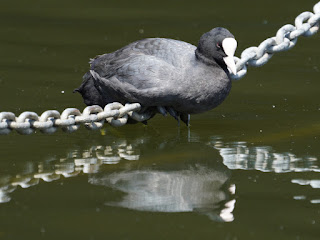The pair under the willow tree were in a very awkward place to view and photograph. I still can't see more than one chick.
The grebes nesting on the west end of the island have finished their nest and are now settled down comfortably.
The unstoppable Coots in the Long Water near the Italian Garden have produced yet another brood, and there were three chicks on the ornamental rock.
A Coot reclined on a chain at the bridge.
It was the turn of the male Mute Swan to look after the three cygnets on the Serpentine. He wasn't doing his job, and allowed a Coot to chase one of them. Instead of dealing with the Coot he went back to feeding.
The Black Swan rested in the shade. He may be Australian but he is still more affected by the hot sunshine than a white swan.
An Egyptian parent at the Vista kept a Coot away from the goslings.
The new resident Grey Heron in the Dell fished in the stream.
Black-Headed Gulls are beginning to trickle back, and there were four on the posts at Peter Pan.
Young and adult Reed Warblers were dashing in all directions in the reed bed at the Diana fountain. An adult emerged holding a bit of reed seed head. They must have finished with nest building by now. Maybe the young are given seeds as well as insects.
The Little Owl was in a very obscure place in the alder tree. By the time I had been trotting round the tree several times to find an angle she was annoyed, and glared at me over her shoulder.
A Carrion Crow in the Dell dunked a bit of bread in a puddle left by last night's rain.
A Brimstone butterfly drank from a thistle.
A female Emperor dragonfly laid eggs on a fallen iris leaf in one of the Italian Garden fountains.
Duncan Campbell reports that there are still seven Egyptian goslings on the Marble Arch traffic island. The young are now nine weeks old and have fully developed wings. But their parents are still regrowing their flight feathers, so departure will have to be delayed.
Joan Chatterley was in St James's Park. Her picture shows that the White Pelicans are accepting the Black Swans nesting on their rocks. However, if any cygnets emerge, it's possible that the pelicans will try to eat them.














A video of a swan on the Serpentine caught in a plastic hoop featured in a London Evening Standard article today, had you heard anything about this?
ReplyDeleteWhy do the pelicans themselves not breed, are the males neutered? Jim
No, I hadn't. The four-hoop carriers for four cans of beer have been a great threat, and I have seen birds dying from getting stuck in them. However, the grebes in that picture are making sensible use of plastic bags, an available resource that is a much better nest building material than the soggy weed they would have used instead. The Coot that drowned was probably doing the same, and made a false move that got its head stuck in the bag. Usually they can tow these things quickly and efficiently.
DeleteI don't know the answer to your pelican question. I keep my distance from St James's Park and Regents's Park, as the sight of captive pinioned birds is utterly depressing and makes me despise the whimsical cruelty of the human race.
Wow, a brimstone butterfly and the contrasting yellow on mauve colours are stupendous and so natural...
ReplyDeleteThe female emperor dragonfly pic is beautiful with its clear reflection.
The wee owl is so cute...
Last but not least, yes I do wish that human beings using the parks ought and should take care of the parks with diligence and TLC.
Very lucky to get a Brimstone standing still. They are very active butterflies. The complicated thistle flower kept it occupied for a few seconds.
DeleteOuch. I think black swans know that pelicans are dangerous. There are very large pelicans in Australia, so it should be able to recognize them as a threat.
ReplyDeleteI wonder what got into that Coot, to launch itself against innocent cygnets minding their own business. A Coot's natural propensity for senseless fights, I imagine.
There's a Coot nest in the reeds not far from that spot, so I suppose it may have been a territorial thing. Or, as you suggest, just a Coot doing what Coots do.
Delete